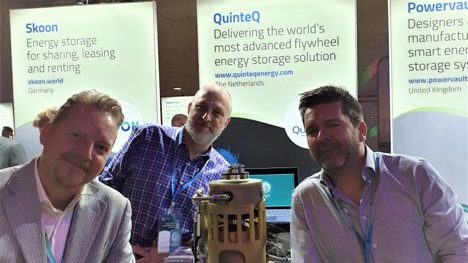
As appeared in the construction magazine ‘Bouwen in het Oosten’
Introducing a new generation of flywheel technology
For twelve and a half years Paul Vosbeek worked as a Cleantech entrepreneur in the US. In that role, he came into contact with the Boeing R&D department whose engineers had been working on the most advanced flywheel technology in the world for about ten years. When Boeing classified this development as ‘non-core IP’, Paul acquired a worldwide IP (Intellectual Property) license for 200 international patents for 15 years. Together with his family and QuinteQ, Paul moved back to the Netherlands late 2018.
“The flywheel technology will become a real Dutch product, which we will market with our partners. Of course we also have international ambitions.”
What it is
The project “Flywheel technology for energy storage in microgrids” is aiming to apply energy storage in a flywheel for decentralized electricity networks (microgrids). The principle of a flywheel is that electrical energy can be converted into kinetic energy by a motor that turns the flywheel at high speed (tens of thousands of revolutions per minute). As soon as there is demand for electrical energy, the motor switches into generator-mode by slowing down the flywheel and thereby releasing electrical energy. The flywheel spins in a vacuum so there is no energy loss through friction. A combination of the flywheel and batteries stabilizes the energy network because it absorbs peaks and dips while at the same time storing energy in a cost-effective manner. The implementation of this project can help to solve bottlenecks in centralized or decentralized energy networks and make the energy infrastructure more future-proof. In this way, the project provides an important contribution to the energy transition and the reduction of CO2 emissions. The technology can be used for military and civilian purposes: for example in humanitarian camps, at large event locations, islands and commercial and industrial applications, like e-mobility, e- logistics, mining industry etc.
Paul introduced his ideas in various regions in the Netherlands. “I found the most welcoming reception for cooperation in a consortium in the Eastern part of the Netherlands”, he explains. The consortium consists of: QuinteQ (energy storage technology), Thales Nederland (military applications and defense industry partner), University of Twente (research partner on energy management systems and data collection) and Saxion Hogescholen (applied research and cyber security).
In addition, for civilian application, the supporting partners are De BouwKlup
(a network organization of construction-related organizations that helps with market positioning and development), Bredenoord Group and the Siers Group.
Most promising technology in energy transition
In 2019, QuinteQ won the Enpuls Challenge as “the most promising technology in the energy transition”. The first milestone in the Netherlands was accomplished. In addition, QuinteQ received support from the Ministries of Economic Affairs & Climate and Defense. OP OOST awarded the consortium a grant to further develop the Flywheel technology for energy storage in microgrids. Paul: “I am happy that my American experiences can be put to good use in the Netherlands. That encourages me every day to continue to develop this technology, together with our partners. ” The consortium identifies potential applications for the technology and this is how Paul came into contact with the Siers Group, which is also a member of the BouwKlup.
Manager Ben Olde Boerrigter: “Siers Groep is constantly working on innovation and applications for new energy solutions. For example, we participate in LomboxNet Utrecht, a city-wide network of public charging stations that use bidirectional charging systems. The flywheel technology suits us well. This stationary storage technique can absorb power peaks at lightning speed. And with that it is also interesting for applications in emergency back-up situations. Trainee Tom Siers adds; “It is a complex technology and a very interesting challenge for us to combine with our market access and know-how. We have a lot of confidence in QuinteQ’s approach and, as a launching partner, Siers is happy to cooperate in the scaling-up of this company. In addition to a solid technology, the right market setting is crucial: the proposition must be both financially and practically profitable. How can you demonstrate your added value? We are thinking about sales markets and segments. We see opportunities for public infrastructure, hospitals and the commercial & industrial market, for example.”
Pilot project
The consortium is currently working on the first prototypes, simulation tools, tests and modelling. The actual implementation is expected to take place in 2021.
The OP Oost project runs until 08/30/2022. Of course there are plans for afterwards, Paul says: “We have an international market view and are already working on our international customer and partner relationships.”
Seminar on September 15, 2020
On Tuesday, September 15, the consortium is organizing an online seminar on microgrids in general and the role of storage. Specific cases are discussed separately in which flywheel storage technology can be used. Both national and international partners will share their experiences.
Vosbeek about the corona crisis: “Apart from some delay in the delivery of some components, this project is moving forward according to plan. For me, the crisis has strengthened my realization that we need to organize our critical resources locally. Energy is one of them.”
The BouwKlup is the active platform for the broader construction and real estate industry. In an open atmosphere, members challenge each other to lead the way. The network thinks in sustainable solutions. The members embrace innovation, but from a practical perspective and actively and substantively contribute to it. https://www.debouwklup.nl


